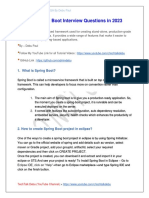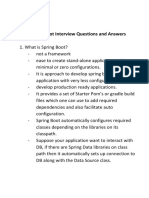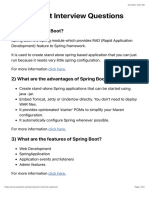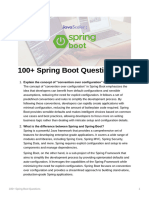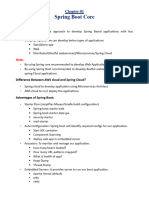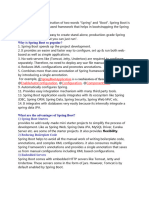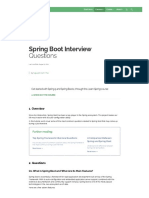Basic Spring Boot Interview Questions and Answers
Uploaded by
Prashant MishraBasic Spring Boot Interview Questions and Answers
Uploaded by
Prashant MishraBasic Spring Boot interview questions and answers
1.
What is Spring Boot, and how does it differ from Spring Framework?
Hide Answer
Spring Boot is a framework designed to simplify the development of Spring-based applications. It
builds upon the Spring Framework, providing a convention-over-configuration approach and auto-
configuration capabilities.
Unlike the Spring Framework, which requires explicit configuration, Spring Boot aims to minimize
boilerplate code and provides defaults for various components. This makes it easier to get started
with Spring-based applications.
2.
Explain the benefits of using Spring Boot for application development.
Hide Answer
Some benefits of using Spring Boot for application development include:
• Simplified setup and configuration through auto-configuration and starter dependencies.
• Reduced boilerplate code, enabling developers to focus more on application logic.
• Embedded server support, allowing applications to be run as standalone JAR files.
• Enhanced testability through the provision of t est utilities and annotations.
3.
What are the key features of Spring Boot?
Hide Answer
Key features of Spring Boot include:
Auto-configuration: Automatically configures Spring-based applications based on dependencies and
defaults.
Starter dependencies: Pre-packaged dependencies that simplify the setup of specific application
features or technologies.
Developer tools: Tools that enhance developer productivity such as automatic application restarts
and live reload.
Actuator: Provides endpoints for monitoring and managing applications at runtime.
4.
Explain the concept of Spring Boot starters and provide an example.
Hide Answer
In the context of Spring Boot, Starters are a set of convenient dependency management providers
that one can include in a Spring Boot application. Starters are a collection of dependency descriptors,
which can help simplify your dependency management.
For instance, if you want to get started with Spring JPA, you just have to include the spring-boot-
starter-data-jpa dependency and everything required for it (like Hibernate, Spring Data, etc.) will be
added to your application.
Here's an example of what the Spring Boot Starter for JPA might look like in a pom.xml file:
By including this dependency, Spring Boot provides all the required dependencies for creating a JPA
application.
5.
What is the purpose of the @SpringBootApplication annotation?
Hide Answer
The @SpringBootApplication annotation is a convenience annotation provided by Spring Boot. It
serves as the entry point for the Spring Boot application. It combines three commonly used
annotations: @Configuration, @EnableAutoConfiguration, and @ComponentScan.
With @SpringBootApplication, developers can enable auto-configuration, component scanning, and
configuration properties in a single step.
6.
What is the default port number for a Spring Boot application?
Hide Answer
The default port number for a Spring Boot application is 8080. However, you can change it by
specifying the desired port number in the application's configuration file (e.g., application.properties
or application.yml) using the property server.port.
7.
How can you enable the auto-configuration feature in Spring Boot?
Hide Answer
Auto-configuration is enabled by default in Spring Boot. It leverages the classpath and the defined
dependencies to automatically configure the application. Spring Boot analyzes the dependencies and
uses their presence to configure various components such as data sources, web servers, and
messaging systems.
If needed, you can disable specific auto-configuration classes or customize the configuration by
providing your own beans.
8.
Explain the concept of starters in Spring Boot.
Hide Answer
Starters in Spring Boot are a set of dependencies that make it easier to configure and use specific
features or technologies in an application. They encapsulate the required dependencies and
configurations, allowing developers to add them to their projects with minimal effort.
For example, the spring-boot-starter-web starter includes all the necessary dependencies for building
web applications including the Spring MVC framework, embedded web server, and JSON support.
9.
How does Spring Boot handle external configuration?
Hide Answer
Spring Boot provides multiple ways to handle external configurations. It supports property files
(application.properties or application.yml) that can be placed in various locations including the
classpath, file system, or external directories.
Spring Boot also supports environment variables, command-line arguments, and the use of profiles
for different deployment environments. The configuration values can be accessed using the @Value
annotation or by binding them to Java objects using the @ConfigurationProperties annotation
10.
What is the purpose of the application.properties (or application.yml) file?
Hide Answer
The application.properties or application.yml file is used for external configuration in a Spring Boot
application. It allows developers to specify various properties and their values to configure the
application.
These properties can control various aspects of the application such as server port, database
connection details, logging configuration, and much more. The properties file can be placed in the
classpath or other predefined locations, and Spring Boot will automatically load and apply the
configuration during application startup.
11.
Describe the Spring Boot auto-configuration mechanism.
Hide Answer
The Spring Boot auto-configuration mechanism automatically configures the Spring application based
on the dependencies present in the classpath. It uses the concept of conditionals to determine which
beans and configurations should be enabled or disabled.
By analyzing the classpath and the available configuration, Spring Boot can provide sensible defaults
and reduce the need for explicit configuration. This makes it easier to start and configure a Spring
application.
12.
What is the purpose of the @Component annotation in Spring Boot?
Hide Answer
The @Component annotation is a core annotation from the Spring Framework and is also used in
Spring Boot. It is a generic stereotype annotation used to mark a class as a Spring-managed
component.
Components are auto-detected by Spring and can be used for dependency injection and component
scanning. The @Component annotation serves as a base annotation for more specific annotations
like @Repository, @Service, and @Controller.
13.
Explain the difference between @Component, @Repository, @Service, and @Controller annotations
in Spring Boot.
Hide Answer
@Component: It is a generic stereotype annotation used to mark a class as a Spring-managed
component. It is a broad and generic term that can be used for any type of Spring-managed
component.
@Repository: It is a specialized form of @Component used to indicate that a class is a repository or
data access component. It typically encapsulates database operations and exception translation.
@Service: It is a specialized form of @Component used to indicate that a class is a service
component. It encapsulates business logic and is often used as an intermediate layer between
controllers and repositories.
@Controller: It is a specialized form of @Component used to indicate that a class is a web controller
component. It handles incoming requests, performs business logic, and prepares the response to be
sent back to the client.
14.
What is the role of the @Autowired annotation in Spring Boot?
Hide Answer
The @Autowired annotation is used for dependency injection in Spring Boot. When applied to a
field, setter method, or constructor, it allows Spring to automatically resolve and inject the required
dependencies.
By using @Autowired, developers don't need to manually instantiate and wire dependencies. Spring
Boot scans the application context for beans matching the required type and injects them
automatically.
15.
How can you implement logging in a Spring Boot application?
Hide Answer
In a Spring Boot application, logging is typically implemented using a logging framework such as
Logback or Log4j2. Spring Boot provides a default logging configuration out of the box.
You can configure logging levels, appenders, and log formats using the application.properties or
application.yml file. Additionally, you can include the desired logging framework dependencies in
your project's build configuration and use the framework's APIs to perform logging within your
application code.
16.
What is the purpose of the SpringApplication.run() method?
Hide Answer
The SpringApplication.run() method is used to bootstrap and launch a Spring Boot application. It is
typically invoked from the main method of the application's entry point class.
The run() method initializes the Spring application context, performs auto-configuration, starts the
embedded server, and starts the application lifecycle. It returns an instance of the
ApplicationContext, allowing access to the application context and its beans.
17.
What is Spring Boot CLI?
Hide Answer
Spring Boot Command Line Interface (CLI) is a command line tool that you can use to run and test
Spring Boot applications from a command prompt. It provides a fast way to get Spring applications
up and running. The CLI incorporates spring scripts into the unix-based shell to launch the boot
applications.
Some of the advantages of using Spring Boot CLI are:
• It allows you to write your application using Groovy, which is a more succinct and expressive
alternative to Java.
• It automatically includes useful external libraries whenever possible. For example, if you're
writing a web application and importing classes such as @RestController, the CLI will
automatically provide a dependency for Spring MVC.
• You can use various commands for different operations like run (to run the application), test
(to test the application), jar (to create a jar file), init (to create a basic Java or Groovy
project), etc.
18.
How does Spring Boot handle data validation?
Hide Answer
In Spring Boot, data validation can be performed using various mechanisms. One common approach
is to use the validation annotations provided by the Bean Validation API, such as @NotNull, @Size,
and @Pattern, on the fields of model objects.
By including the necessary validation annotations, Spring Boot automatically validates the input data
and generates validation errors. These errors can be handled using BindingResult or Errors objects.
Additionally, custom validation logic can be implemented by creating custom validation classes and
methods.
19.
What is the purpose of the @RequestMapping annotation in Spring Boot?
Hide Answer
The @RequestMapping annotation is used to map HTTP requests to specific handler methods in a
Spring Boot application. It is applied at the method or class level to define the URL patterns that
should trigger the execution of the annotated method.
@RequestMapping allows developers to specify various attributes, such as the HTTP method (GET,
POST, etc.), request parameters, headers, and more to further refine the mapping.
20.
How does Spring Boot integrate with containerization platforms like Docker and Kubernetes?
Hide Answer
Spring Boot integrates seamlessly with containerization platforms like Docker and Kubernetes. You
can package a Spring Boot application as a Docker image by creating a Dockerfile that includes the
necessary dependencies and configurations.
The image can be built and deployed to a containerization platform like Docker Swarm or
Kubernetes. Spring Boot also provides features like externalized configuration and health indicators
which can be leveraged by container orchestration platforms for efficient management and scaling of
the application.
21.
Explain the concept of message-driven microservices using Spring Boot and Apache Pulsar.
Hide Answer
Message-driven microservices using Spring Boot and Apache Pulsar leverage the publish-subscribe
messaging pattern to enable loosely coupled and scalable communication between microservices.
Apache Pulsar acts as the messaging system, and Spring Boot provides the necessary abstractions for
consuming and producing messages.
With Pulsar's messaging features and Spring Boot's integration, you can implement event-driven
architectures where microservices communicate asynchronously through messages. This ensures
decoupling and fault tolerance.
22.
What is the purpose of the @Value annotation in Spring Boot?
Hide Answer
The @Value annotation is used to inject values from properties files, environment variables, or other
sources into Spring-managed beans. It can be applied to fields, methods, or constructor parameters.
With @Value, developers can easily access and use configuration properties or other values within
their application code. The values can be specified directly or referenced using SpEL (Spring
Expression Language) expressions.
23.
Describe the role of the CommandLineRunner and ApplicationRunner interfaces in Spring Boot.
Hide Answer
In Spring Boot, the CommandLineRunner and ApplicationRunner interfaces are used for performing
specific tasks during the application startup process. When implemented, these interfaces provide a
callback method (run()) that gets executed once the application context is initialized.
They are particularly useful for performing tasks like data initialization, cache population, or other
one-time setup operations. The main difference between them is that CommandLineRunner receives
the application's command-line arguments as a parameter, while ApplicationRunner receives an
ApplicationArguments object.
24.
How can you implement pagination in a Spring Boot application?
Hide Answer
To implement pagination in a Spring Boot application, you can utilize features provided by libraries
like Spring Data JPA or Spring Data MongoDB. They offer built-in support for pagination through the
use of Pageable objects and repository methods.
You can retrieve a subset of data from a larger dataset by specifying the page number, page size, and
sort criteria. The result is typically returned as a Page object that contains the requested data along
with metadata such as total elements, total pages, and more.
25.
Explain the concept of bean scopes in Spring Boot.
Hide Answer
Bean scopes define the lifecycle and visibility of Spring-managed beans in a Spring Boot application.
The following are the commonly used bean scopes:
Singleton (default): Only one instance of the bean is created and shared across the entire application
context.
Prototype: A new instance of the bean is created each time it is requested.
Request: A new instance of the bean is created for each HTTP request. It is only applicable in a web
application context.
Session: A new instance of the bean is created for each user session. It is only applicable in a web
application context.
Custom scopes: Spring Boot allows defining custom bean scopes by implementing the Scope
interface and registering them in the application context.
26.
What is the purpose of the @Qualifier annotation in Spring Boot?
Hide Answer
The @Qualifier annotation in Spring is used to disambiguate bean references when we have multiple
beans of the same type defined in the Spring container. It is used in scenarios where a given type has
more than one implementation and we need to inject a specific implementation.
By default, Spring uses the by-type autowiring mechanism. This means that if we have more than
one bean of the same type, Spring will throw a NoUniqueBeanDefinitionException because it won't
know which one to autowire.
The @Qualifier annotation can be used in conjunction with @Autowired to specify which exact bean
should be wired, by providing the name of the bean as the qualifier value.
27.
How does Spring Boot handle exception logging and error handling?
Hide Answer
In Spring Boot, exception logging and error handling can be configured using various mechanisms.
Spring Boot automatically provides a default error page that displays a standardized error message
for unhandled exceptions.
However, you can customize the error-handling behavior by implementing exception handlers using
the @ControllerAdvice annotation and handling specific exceptions in dedicated methods.
Additionally, you can configure logging frameworks to capture and log exceptions with desired levels
of detail and appenders.
28.
Describe the purpose and usage of the @RestControllerAdvice annotation.
Hide Answer
The @RestControllerAdvice annotation is a specialized form of the @ControllerAdvice annotation in
Spring Boot. It combines the functionality of @ControllerAdvice and @ResponseBody, making it
convenient for implementing global exception handling in RESTful APIs.
By using @RestControllerAdvice, you can define exception handlers that handle exceptions thrown
by any @RequestMapping or @RestController method within the application. The exception
handlers can return error responses in JSON or other supported formats.
29.
What is the purpose of the @ConfigurationProperties annotation in Spring Boot?
Hide Answer
The @ConfigurationProperties annotation is used to bind external configuration properties to Spring-
managed beans. By annotating a bean class with @ConfigurationProperties and specifying a prefix,
you can map properties with matching names to the fields or setter methods of the bean.
Spring Boot will automatically bind the values from the configuration sources to the corresponding
bean properties. The annotation simplifies the retrieval and usage of configuration properties within
your application.
30.
Describe the purpose and usage of the @DynamicPropertySource annotation in Spring Boot testing.
Hide Answer
The @DynamicPropertySource annotation in Spring Boot testing allows you to dynamically define
and modify configuration properties during the test execution. You can use this annotation in
conjunction with the TestPropertyValues class to set or override properties based on dynamic values
or test conditions.
This provides flexibility in configuring the environment for testing and allows you to simulate
different scenarios or configurations during testing.
31.
What is the purpose of the @TransactionalEventListener annotation in Spring Boot?
Hide Answer
The @TransactionalEventListener annotation in Spring Boot lets you listen to transactional events
and perform actions based on those events. You can use this annotation on methods that should be
invoked when a specific transactional event occurs such as before or after a transaction is committed
or rolled back.
The @TransactionalEventListener annotation provides a convenient way to handle domain-specific
logic or side effects based on transactional events in a Spring Boot application.
32.
What is the purpose of the @Scheduled annotation in Spring Boot?
Hide Answer
The @Scheduled annotation is used to configure scheduled tasks in a Spring Boot application.
Applying this annotation to a method enables you to specify the schedule at which the method
should be executed.
The schedule can be defined using various options such as fixed-rate, fixed-delay, or cron
expressions. Spring Boot automatically detects and executes the scheduled methods based on the
specified schedule.
33.
Describe the role of the @Profile annotation in Spring Boot.
Hide Answer
The @Profile annotation is used to activate or deactivate specific configuration components or beans
based on the current environment or profile in a Spring Boot application. Annotating a class or
method with @Profile and specifying the desired profile name lets you control when that component
or bean should be active. This allows you to have different configurations for different deployment
environments such as development, testing, or production.
34.
What is the purpose of Spring Boot's dynamic reloading and how does it work?
Hide Answer
Spring Boot's dynamic reloading feature allows you to make changes to the application code or
resources without the need to restart the entire application. It improves development productivity
by automatically reloading the modified classes or resources on the fly.
The dynamic reloading feature uses class reloading mechanisms provided by the underlying JVM,
such as Java Instrumentation API or custom class loaders, to reload the changed classes while
preserving the application's state.
35.
Explain the concept of externalized logging in Spring Boot using Logback or Log4j2.
Hide Answer
Externalized logging in Spring Boot allows you to configure and customize logging behavior without
modifying the application code. Logback or Log4j2 can be used as the underlying logging framework.
The configuration is typically done in an external configuration file, such as logback.xml or log4j2.xml,
which can be placed in the classpath or specified using the logging.config property. The externalized
logging configuration file provides flexibility in defining log levels, appenders, formatters, and other
logging-related properties.
36.
What is the purpose of the @ModelAttribute annotation in Spring Boot?
Hide Answer
The @ModelAttribute annotation is used in Spring Boot to bind request parameters or form data to
method parameters or model attributes. It can be applied to method parameters or method return
values.
When applied to method parameters, the @ModelAttribute annotation binds the incoming request
parameters or form data to the corresponding method parameters. When applied to method return
values, it binds the method's return value to a model attribute, making it available in the view for
rendering.
37.
Explain the concept of reactive messaging with Spring Boot and Apache Kafka Streams.
Hide Answer
Reactive messaging with Spring Boot and Apache Kafka Streams enables the building of real-time
streaming applications that react to events and reactively process data streams. Spring Cloud Stream
provides abstractions to integrate Spring Boot applications with Kafka Streams.
With @StreamListener annotations, you can consume Kafka topics as reactive streams and perform
processing operations using the reactive programming model. This approach facilitates the
development of scalable and resilient streaming applications.
38.
Describe the purpose and usage of the @Transactional(propagation = Propagation.NESTED)
annotation.
Hide Answer
The @Transactional(propagation = Propagation.NESTED) annotation is used to define a nested
transactional scope in a Spring Boot application. When a method is annotated with this annotation, a
nested transaction is created within the current transaction.
The nested transaction behaves as an independent transaction and can be rolled back separately
from the outer transaction. If the nested transaction fails, only the changes made within the nested
transaction are rolled back, while the outer transaction remains unaffected.
39.
What is the purpose of the @DataJpaTest annotation in Spring Boot testing?
Hide Answer
The @DataJpaTest annotation is used to configure and customize the testing environment for JPA
repositories in a Spring Boot application. When applied to a test class, it sets up an in-memory
database, configures Spring Data JPA, and loads only the necessary components for testing JPA
repositories.
@DataJpaTest provides a lightweight and isolated environment for testing JPA-related functionality
without requiring a full application context or a real database connection.
40.
Describe the purpose and usage of the Spring Boot Admin Server for monitoring and managing
applications.
Hide Answer
The Spring Boot Admin Server is a tool that provides a web-based interface for monitoring and
managing multiple Spring Boot applications in a centralized manner. It collects and displays various
metrics, health statuses, and other information about the registered Spring Boot applications.
The Admin Server allows you to view and manage application details, monitor JVM metrics, and
receive alerts on specific conditions. It simplifies the monitoring and management of Spring Boot
applications in a production environment.
Looking for remote developer job at US companies?
Work at Fortune 500 companies and fast-scaling startups from the comfort of your home
Apply Now
Intermediate Spring Boot interview questions and answers
1.
Differentiate between Spring MVC and Spring Boot.
Hide Answer
Spring MVC is a framework for building web applications using the Model-View-Controller (MVC)
architectural pattern. It provides features for handling requests, managing controllers, rendering
views, and managing data flow.
Spring Boot, on the other hand, is an opinionated framework built on top of Spring that aims to
simplify the setup and configuration of Spring applications. It provides out-of-the-box defaults and
auto-configuration, reducing the need for manual configuration and boilerplate code.
2.
What is the role of the @RestController annotation in Spring Boot?
Hide Answer
The @RestController annotation is used to define a RESTful controller in a Spring Boot application. It
combines the functionality of the @Controller and @ResponseBody annotations, simplifying the
process of building RESTful APIs by automatically serializing the return values of methods into JSON
or XML responses.
3.
How can you implement exception handling in a Spring Boot application?
Hide Answer
Exception handling in Spring Boot can be implemented using the @ControllerAdvice annotation. By
creating a class annotated with @ControllerAdvice and defining methods annotated with
@ExceptionHandler, you can handle specific exceptions and return appropriate responses.
You can also use the @ResponseStatus annotation to specify the HTTP status code for the response.
4.
Explain the concept of dependency injection in Spring Boot.
Hide Answer
Dependency injection is a core concept in Spring Boot. It allows objects to be loosely coupled by
providing their dependencies from external sources. Spring Boot uses inversion of control (IoC) and
the dependency injection pattern to manage dependencies.
Spring Boot automatically resolves and injects the required dependencies at runtime by annotating
classes with appropriate annotations such as @Autowired.
5.
How does Spring Boot support database operations?
Hide Answer
Spring Boot provides excellent support for database operations through its integration with Spring
Data JPA. By defining entities and repositories, you can perform CRUD (Create, Read, Update, Delete)
operations on databases with minimal boilerplate code.
Spring Boot automatically configures the database connection and transaction management, and
provides powerful querying capabilities.
6.
Describe the role of the Spring Boot Actuator.
Hide Answer
Spring Boot Actuator is a feature that provides insight into the runtime of a Spring Boot application.
It offers a set of production-ready endpoints that expose information about application health,
metrics, environment, logging, and more.
The Actuator enables monitoring and management of the application, making it easier to understand
and troubleshoot in production environments.
7.
How can you implement caching in a Spring Boot application?
Hide Answer
Caching in a Spring Boot application can be implemented using the @Cacheable, @CacheEvict, and
other cache-related annotations provided by the Spring Framework. Adding these annotations to
methods lets you cache the results and improve performance. Spring Boot integrates with popular
caching providers like Ehcache, Hazelcast, and Redis.
8.
What is the purpose of the @Scheduled annotation in Spring Boot?
Hide Answer
The @Scheduled annotation is used to schedule the execution of a method at fixed intervals or
specific times. It allows you to define cron expressions or fixed delay/initial delay values. Spring Boot
automatically triggers the annotated method based on the specified schedule, making it suitable for
performing recurring tasks such as data synchronization or sending periodic notifications.
9.
How can you enable cross-origin resource sharing (CORS) in a Spring Boot application?
Hide Answer
To enable CORS in a Spring Boot application, you can use the @CrossOrigin annotation at the
controller level or globally configure CORS using a WebMvcConfigurer bean. The annotation allows
you to specify the allowed origins, HTTP methods, headers, and other CORS-related settings.
Enabling CORS ensures that web browsers can make requests to your application from different
domains.
10.
Explain the concept of profiles in Spring Boot.
Hide Answer
Profiles in Spring Boot allow you to define different configurations for different environments or
scenarios. By using the @Profile annotation on classes or methods, you can specify which profiles
should be active for the corresponding beans or configurations.
Profiles enable you to have different property values, component configurations, or dependencies
based on the active profile. This facilitates easy deployment and testing across different
environments.
11.
Explain the concept of the Spring Boot Actuator and its major features.
Hide Answer
Spring Boot Actuator provides a set of production-ready features and endpoints that help monitor
and manage a Spring Boot application.
Its major features include health checks, which provide information about the application's health;
metrics, which gather and expose various runtime metrics; info, which displays custom application
information; logging, which allows changing log levels at runtime, and many more endpoints for
managing and understanding the application in a production environment.
12.
How can you integrate Spring Security in a Spring Boot application?
Hide Answer
To integrate Spring Security in a Spring Boot application, you need to add the appropriate
dependencies and configure security settings. Spring Security provides comprehensive
authentication and authorization mechanisms.
You can configure security rules using Java configuration or annotations, define user roles and
permissions, and customize authentication providers, such as in-memory authentication, database-
backed authentication, or integration with external identity providers.
13.
Describe the role of the @Transactional annotation in Spring Boot.
Hide Answer
The @Transactional annotation is used to mark a method or class for transaction management in
Spring Boot. It ensures that the annotated method or all methods within the annotated class are
executed within a transactional context.
The @Transactional annotation manages the transaction boundaries, rollback behavior, and other
transactional aspects to ensure data consistency and integrity.
14.
How does Spring Boot handle internationalization (i18n) and localization (l10n)?
Hide Answer
Spring Boot automatically resolves the appropriate message based on the user's locale, making it
convenient to build multi-language applications. It provides support for internationalization and
localization through properties files and the use of the MessageSource interface.
By defining message bundles for different locales and configuring the message source, you can easily
retrieve and display localized messages in your application.
15.
What is the purpose of the @RestControllerAdvice annotation?
Hide Answer
The @RestControllerAdvice annotation combines the functionalities of @ControllerAdvice and
@ResponseBody annotations. It is used to define a global exception handler for RESTful controllers in
a Spring Boot application.
Annotated classes can contain exception-handling methods annotated with @ExceptionHandler
which handles exceptions thrown within any @RestController in the application. These methods can
return custom error responses or perform other actions based on the exception type.
16.
Explain the concept of Spring Data REST and its advantages.
Hide Answer
Spring Data REST is a project built on top of Spring Data, it takes the features of Spring HATEOAS and
Spring Data to build Spring MVC-based RESTful services with less code. With Spring Data REST, you
can leverage your Spring Data repositories and convert them into full-featured RESTful services with
ease.
Some of its advantages are:
Rapid Development: With Spring Data REST, a great deal of your HTTP resource implementation time
can be saved. It's quick and easy to build a RESTful service with full CRUD functionality.
Data Access: It leverages Spring Data's repositories and provides seamless, RESTful access to your
data model.
HAL Browser: Spring Data REST includes support for the HAL Browser, allowing users to navigate,
create, update, and delete resources directly from their web browsers.
Search Support: It has built-in support for searches. Custom repository methods are automatically
exposed as HTTP resources.
17.
How can you implement file upload and download functionality in a Spring Boot application?
Hide Answer
File upload and download functionality can be implemented in a Spring Boot application by
configuring multipart file handling. By using the MultipartFile object as a method parameter, Spring
Boot automatically binds uploaded files to it.
For file download, you can return the file as a response with appropriate headers. Additionally, you
can leverage storage services like Amazon S3 or Azure Blob Storage for file storage and retrieval.
18.
Describe the purpose and usage of the @Async annotation in Spring Boot.
Hide Answer
The @Async annotation is used to indicate that a method should be executed asynchronously. When
a method is annotated with @Async, Spring Boot runs it in a separate thread from a task executor,
allowing the caller to continue execution without waiting for the asynchronous method to complete.
This annotation is useful for offloading time-consuming tasks, improving performance, and providing
a more responsive user experience.
19.
What is the role of the embedded servlet container in Spring Boot?
Hide Answer
The embedded servlet container in Spring Boot allows you to run web applications without the need
for a separate web server. It provides a lightweight servlet container, such as Tomcat, Jetty, or
Undertow, that is embedded within the application.
Spring Boot automatically configures and starts the embedded servlet container, simplifying the
deployment and execution of web applications.
20.
How can you implement request and response logging in a Spring Boot application?
Hide Answer
Request and response logging in a Spring Boot application can be implemented using filters or
interceptors. Creating a custom filter or interceptor lets you intercept incoming requests and
outgoing responses and log their details, such as headers, payloads, and other relevant information.
Spring Boot allows you to register these filters or interceptors in the application's configuration,
enabling centralized logging across the application.
21.
Explain the concept of reactive data access in Spring Boot using Spring Data R2DBC.
Hide Answer
Reactive data access in Spring Boot allows you to build non-blocking and efficient applications that
handle a large number of concurrent requests. Spring Data R2DBC provides reactive database access
by integrating with R2DBC (Reactive Relational Database Connectivity).
It enables you to perform asynchronous database operations using reactive programming paradigms,
such as Flux and Mono, providing better scalability and responsiveness compared to traditional
blocking database access.
22.
How can you perform asynchronous messaging using Spring Boot and RabbitMQ?
Hide Answer
Asynchronous messaging using Spring Boot and RabbitMQ can be achieved by integrating the Spring
AMQP (Advanced Message Queuing Protocol) library. By configuring the RabbitMQ connection
details and using the appropriate annotations and components, you can send and receive messages
asynchronously.
Spring Boot provides abstractions like @RabbitListener for message consumption and
RabbitTemplate for message production. They make it easy to implement asynchronous messaging
patterns like publish-subscribe and request-reply.
23.
Describe the purpose and usage of the @Conditional annotation in Spring Boot.
Hide Answer
The @Conditional annotation in Spring Boot allows you to conditionally activate or deactivate beans
or configurations based on specific conditions. By annotating a bean or configuration class with
@Conditional and providing a condition class implementing the Condition interface, you can control
whether the bean or configuration should be created and registered based on runtime conditions.
This enables flexible configuration based on environment, properties, or other factors.
24.
What is the purpose of the @SpringBootTest annotation in Spring Boot testing?
Hide Answer
The @SpringBootTest annotation is used to bootstrap a Spring Boot application context for testing
purposes. It allows you to load the entire application context, including all configurations and beans,
during integration tests.
@SpringBootTest provides features like auto-configuration, dependency injection, and easy access to
application-specific components, enabling comprehensive testing of Spring Boot applications.
25.
Explain the concept of Spring Boot's actuator health checks and customizing health indicators.
Hide Answer
Spring Boot's actuator health checks are endpoints provided by the Actuator that give insights into
the application's health. By default, health indicators check the overall system health. You can
customize them by implementing the HealthIndicator interface and registering them with the
application context.
Custom health indicators allow you to monitor specific aspects of the application's health such as
database connectivity, external service availability, or custom health checks.
26.
How can you secure REST APIs in a Spring Boot application using JSON Web Tokens (JWT)?
Hide Answer
You can secure REST APIs in a Spring Boot application using JSON Web Tokens (JWT) by integrating
Spring Security and JWT libraries. Spring Security provides mechanisms for authentication and
authorization, while JWT facilitates token-based authentication.
By configuring Spring Security filters, implementing authentication and authorization providers, and
validating JWT tokens, you can protect your REST APIs and control access based on user roles and
permissions.
27.
Describe the purpose and usage of the @EntityScan annotation in Spring Boot.
Hide Answer
The @EntityScan annotation is used to specify the base packages to scan for entity classes in a Spring
Boot application. When using JPA (Java Persistence API) with Spring Boot, @EntityScan helps the JPA
provider locate and manage entity classes.
By default, Spring Boot scans the package of the application's main class and its sub-packages.
However, if entity classes are located in different packages, you need to use @EntityScan to include
those packages.
28.
What is the purpose of the @Retryable annotation in Spring Boot?
Hide Answer
The @Retryable annotation is used to specify that a method should be retried if it fails due to
specified exceptions. Adding @Retryable and configuring the desired retry behavior enables Spring
Boot to automatically retry the method when exceptions occur.
This can be useful for handling transient errors, such as network timeouts or temporary resource
unavailability, and ensuring the successful execution of critical operations.
29.
Explain the concept of auto-reconfiguration in Spring Boot and its limitations.
Hide Answer
Auto-reconfiguration in Spring Boot is a feature that automatically configures certain components
and dependencies based on the classpath and available resources. It simplifies the configuration
process by detecting and configuring components like data sources, messaging brokers, and caches.
Auto-reconfiguration has limitations when it comes to complex or custom configurations. It may not
always provide the desired configuration out of the box. In such cases, manual configuration may be
required.
30.
How can you implement distributed caching in a Spring Boot application using Hazelcast or Redis?
Hide Answer
To implement distributed caching in a Spring Boot application with Hazelcast or Redis, you can
leverage the respective cache providers' integration libraries. Configuring the cache manager and
cache-related settings lets you enable distributed caching.
Spring Boot simplifies the setup and configuration process by providing auto-configuration support
for both Hazelcast and Redis. Additionally, you can annotate methods with cache-related annotations
like @Cacheable or @CacheEvict to cache and retrieve data efficiently.
You might also like
- 100+ Spring Boot Interview Questions and Answers For 2025No ratings yet100+ Spring Boot Interview Questions and Answers For 202543 pages
- Top 85+ Spring Boot QA For 2023 Java DeveloperNo ratings yetTop 85+ Spring Boot QA For 2023 Java Developer44 pages
- Spring Boot Interview Questions: Click HereNo ratings yetSpring Boot Interview Questions: Click Here15 pages
- Top 20 Spring Boot Interview Questions - JavatpointNo ratings yetTop 20 Spring Boot Interview Questions - Javatpoint6 pages
- Java Spring Boot Interview Questions and AnswersNo ratings yetJava Spring Boot Interview Questions and Answers15 pages
- Spring Boot Interview Questions For FreshersNo ratings yetSpring Boot Interview Questions For Freshers17 pages
- Spring Boot Interview Questions and AnswersNo ratings yetSpring Boot Interview Questions and Answers6 pages
- 10 Basic Spring Boot Questions Every Developer Should KnowNo ratings yet10 Basic Spring Boot Questions Every Developer Should Know16 pages
- Spring Boot Interview Questions With Dertailed AnswersNo ratings yetSpring Boot Interview Questions With Dertailed Answers31 pages
- Spring Boot Interview Questions and AnswersNo ratings yetSpring Boot Interview Questions and Answers11 pages
- Spring Boot - MicroServices - Ineuron - AiNo ratings yetSpring Boot - MicroServices - Ineuron - Ai11 pages
- Master Spring Boot With 59 Essential Interview Questions!No ratings yetMaster Spring Boot With 59 Essential Interview Questions!18 pages
- Spring Boot Basic Interview Questions Part 1 1690952442No ratings yetSpring Boot Basic Interview Questions Part 1 169095244230 pages
- What Is Spring Boot and What Are Its BenefitsNo ratings yetWhat Is Spring Boot and What Are Its Benefits25 pages
- Complete Spring Boot Interview QuestionsNo ratings yetComplete Spring Boot Interview Questions5 pages
- Spring Boot Interview Questions and AnswersNo ratings yetSpring Boot Interview Questions and Answers3 pages
- Spring Boot Interview Questions: 1. OverviewNo ratings yetSpring Boot Interview Questions: 1. Overview9 pages
- Spring Boot Interview QA 50 Easy MediumNo ratings yetSpring Boot Interview QA 50 Easy Medium17 pages
- LUFFING TOWER CRANE Tower Crane Specifications - Jib Tower CraneNo ratings yetLUFFING TOWER CRANE Tower Crane Specifications - Jib Tower Crane14 pages
- #1 - Introduction To Management (Chapter 1) #1 - Introduction To Management (Chapter 1)No ratings yet#1 - Introduction To Management (Chapter 1) #1 - Introduction To Management (Chapter 1)6 pages
- w2 - For Students - w2 - Preparation For Chap 5No ratings yetw2 - For Students - w2 - Preparation For Chap 53 pages
- RPG and Story-Based Game in Game DevelopmentNo ratings yetRPG and Story-Based Game in Game Development9 pages
- FAR 1 All S25 Tests & Mock by Sir Nasir AbbasNo ratings yetFAR 1 All S25 Tests & Mock by Sir Nasir Abbas73 pages
- United States District Court Northern District of CaliforniaNo ratings yetUnited States District Court Northern District of California1 page
- C Y9 M93 DPLwe NXTQe NLSW 2 TLNT 8 Oh U7 NuNo ratings yetC Y9 M93 DPLwe NXTQe NLSW 2 TLNT 8 Oh U7 Nu1 page



